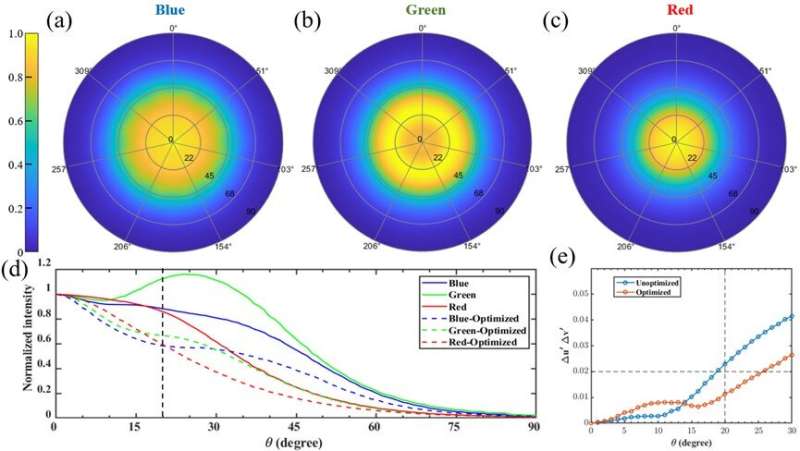Will nanowire LEDs be the ultimate light engine for AR and VR displays?
High resolution density, wide field of view (FoV), lightweight and compact formfactor, and low power consumption are demanding requirements for augmented reality (AR) and virtual reality (VR) displays. Compared to liquid crystal displays (LCDs) and organic light-emitting diode (OLED) displays, microLED is attracting more attention due to its high peak brightness, excellent dark state, high resolution density, small formfactor, and long lifetime.
On the other hand, as the chip size decreases, the microLED efficiency decreases due to sidewall defects. Therefore, the tradeoff of high-resolution density and external quantum efficiency (EQE) is a major challenge to applying microLED as an AR/VR light engine, in addition to high fabrication cost.
Nanowire LEDs show great potential for achieving high-resolution density and high EQE at the same time. Since each pixel is formed by submicron nanowire array, the efficiency of the nanowire LED is independent of pixel size. In 2018, Aledia reported a nanowire LED whose EQE is independent of pitch size when the pitch size is reduced from 1000 μm to 5 μm.
Among different nanowire structures, InGaN/GaN dot-in-wire hexagonal LED is attractive because its emission wavelength can be controlled by the wire diameter and its electrical performance is excellent. The former feature significantly reduces the fabrication difficulties. However, these nanowires exhibit different angular radiation patterns for the red, green and blue colors in the far-field, leading to a noticeable angular color shift.
Additionally, directional light engine is preferred since the accepting cone in AR/VR imaging system is typically within ±20°. Therefore, the geometry of the nanowire should be optimized to achieve matched radiation patterns for the three primary colors, high light extraction efficiency (LEE), and narrow angular luminance distribution simultaneously.
The authors of an article recently published in Opto-Electronic Science optimized the InGaN/GaN nanowire LED geometry by 3D dipole cloud through a commercial wave optics simulation software Finite-Difference Time-Domain (FDTD, Ansys inc.). They propose a multicolor hexagonal single InGaN/GaN dot-in-nanowire LED model based on Ra’s experimental results.
They set a 3D large box monitor and small box monitor to calculate the emission power and dipole power, respectively, which defines the light extraction efficiency (LEE) by their ratio. Additionally, the far-field distribution map is captured by a 2D power monitor placed above the structure.
As indicated in Fig. 1(b), due to the hexagonal symmetry, they simulate two groups of dipoles which are defined by an inscribed circle and circumscribed circle, respectively. The emission wavelength of the dipole sources follows the unfiltered measured emission spectra (solid lines in Fig. 1(c)). All three nanowires without color filters have side lobe emission since the Indium adatom diffusion is difficult to be perfectly controlled. As indicated in the dashed lines in Fig. 1(c), this side lobe emission is suppressed dramatically after applying color filters.

Figure 2(a–c) depicts the calculated normalized 2D angular distribution for blue, green, and red nanowire LEDs, respectively. By sweeping the p-GaN capping height and vertical position of active layers, the authors find the optimal conditions for blue, green, and red nanowire LEDs.
By considering the AR imaging system accepting cone, the authors define the effective LEE to be the LEE within ±20°. After optimization, the effective LEE of blue, green, and red nanowire LEDs increases from [9.3%, 18.8%, 30.6%] to [10.0%, 25.6%, 33.0%], respectively. In comparison with the size-dependent blue and green InGaN µLED and assuming 100% of the produced light can be coupled into the imaging system, their blue nanowire LED shows a better performance than µLED whose mesa size is smaller than 10 µm as shown in Fig. 3(a).

In addition, Fig. 3(b) indicates that the effective LEE of green nanowire LEDs is even higher than that of the 80-µm µLED. Compared to AlGaInP red µLEDs, their red nanowire LED is more efficient than that with 20-µm chip size (Fig. 3(c)). Remarkably, in comparison with the 10-µm mesa size, the blue nanowire LED provides a similar brightness, while green and red nanowire LEDs can offer 1.6x and 1.4x higher efficiency, respectively. Therefore, nanowire LEDs show a pronounced higher efficiency than µLED under small pixel size and high-resolution density.
Yizhou Qian et al, Directional high-efficiency nanowire LEDs with reduced angular color shift for AR and VR displays, Opto-Electronic Science (2022). DOI: 10.29026/oes.2022.220021
Provided by
Compuscript Ltd
Citation:
Will nanowire LEDs be the ultimate light engine for AR and VR displays? (2023, January 12)
retrieved 12 January 2023
from https://techxplore.com/news/2023-01-nanowire-ultimate-ar-vr-displays.html
This document is subject to copyright. Apart from any fair dealing for the purpose of private study or research, no
part may be reproduced without the written permission. The content is provided for information purposes only.
For all the latest Technology News Click Here
For the latest news and updates, follow us on Google News.
